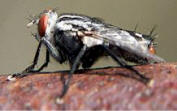
Larva - These near white to yellowish maggots have pointed heads. Depending on the species, they range from 10 to 22 mm in length when fully grown.
Distribution - As a group, flesh flies occur throughout most areas of the world although species distribution varies. Flesh flies are
 found in urban and rural communities but, fortunately, are relatively
uncommon in houses or restaurants. They breed in excrement, decaying
vegetable matter and animal flesh or meat.
found in urban and rural communities but, fortunately, are relatively
uncommon in houses or restaurants. They breed in excrement, decaying
vegetable matter and animal flesh or meat.
Feeding Habits - Adult flies do not bite but feed on a wide
range of liquid substances. Most larvae infest wounds, carrion or
excrement. The larvae of some species of flesh flies are beneficial in
that they prey on eggs, nymphs, or larvae of more harmful insects.
Lesser house fly larvae, blow fly larvae, and grasshopper nymphs are
common hosts of flesh flies.
Damage - Though they can carry leprosy bacilli, flesh flies
usually are not problems as disease carriers or even as nuisances and
pose little threat to human welfare or to livestock. A few cases are
known in which flesh fly maggots have burrowed from wounds into the
healthy flesh of livestock, and some species can cause intestinal
pseudomyiasis (infection by fly larvae) in humans who consume food
contaminated with larvae.
Life History - Flesh fly life histories vary with species and
location. They overwinter as pupae in North Carolina and other temperate
climates. Rarely very numerous, the flies emerge in spring and mate.
Eggs are laid only under very unusual circumstances. As a rule, eggs
hatch within the body of the adult. Females of most species deposit 20
to 40 larvae directly onto the host or substrate. As many as 325 larvae
have been known to be born by a single female.
Flesh fly maggots feed for 3 or 4 days and develop through 3 instars.
Soon afterward, these mature maggots enter the pupal stage. Adult flies
emerge in 10 to 14 days and the life cycle is repeated. Several
generations are produced each year.

 hence their common name. Some flesh fly larvae are internal parasites of
other insects. These larvae, commonly known as maggots, live for about
5-10 days, before descending into the soil and maturing into adulthood.
At that stage, they live for 5-7 days.
hence their common name. Some flesh fly larvae are internal parasites of
other insects. These larvae, commonly known as maggots, live for about
5-10 days, before descending into the soil and maturing into adulthood.
At that stage, they live for 5-7 days.